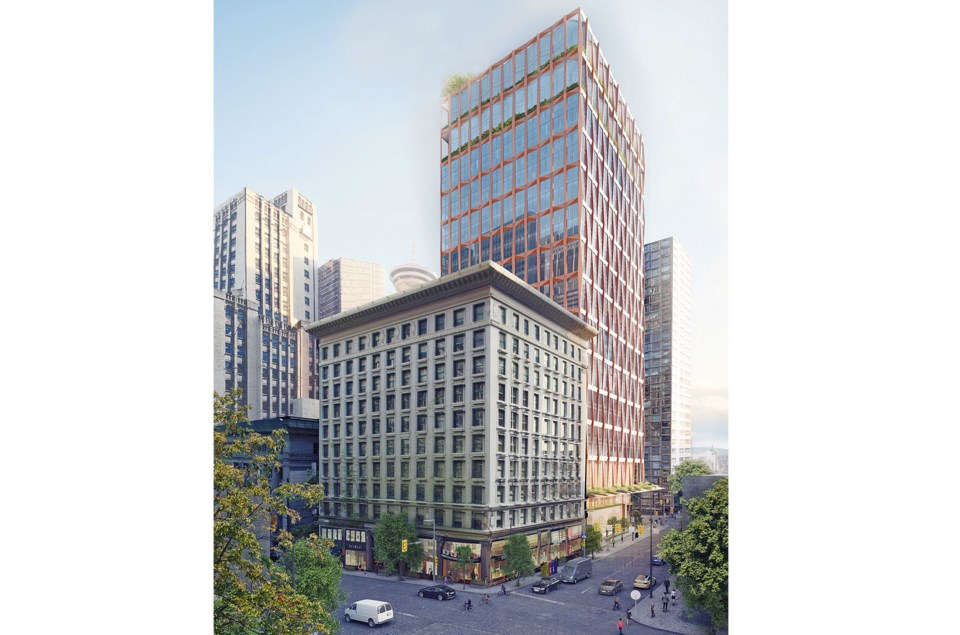There is four million square feet of new office space under construction in downtown Vancouver, the most in the city’s history, but it still does not keep pace with what is also historic demand.
Vancouver has among the lowest office vacancy rates in North America, according to recent CBRE reports, at 2.4 per cent.
Three of the first four office towers being built are already 100 per cent pre-leased and, as of the third quarter of 2019, more than 325,000 square feet of existing space had been taken up, despite escalating lease rates.
The demand for downtown offices mirrors the diversity of the B.C. economy. The big space takers now are not resource-based firms. In 2019, 51.5 per cent of the pre-leasing activity was from the technology industry, co-working firms took 20.9 per cent and business services claimed 13.1 per cent of the new space.
Amazon, for example, pre-leased the entire 1.1 million square feet of Class AA space at the Post, the QuadReal redevelopment of the old Canada Post headquarters on West Georgia Street.
The unprecedented performance has persuaded investors to pay top dollar for older buildings with an eye to future development.
Recent investments include the sale of a 29,000-square-foot, 110-year-old office building at 101 Smithe Street for $27.3 million in April of last year, a price that pencils out to $913 per square foot for a Class B space. The Burrard Medical Building, a fixture at 1140 Burrard Street since 1972, sold in May for $17.3 million, more than $500,000 above its current assessed value.
“The challenge for Vancouver is the lack of product, not purchasers,” understated a December report on Metro Vancouver commercial real estate from Altus Group.
In the first half of 2019 $2.1 billion worth of office space was sold, a near-record high. The billion-dollar sale of the Bentall Centre office complex in downtown Vancouver was followed by an announcement from its U.S. buyers that it will expand with a 500,000-square-foot commercial tower.
Downtown Vancouver office lease rates for Class A offices are now $55 to $95 per square foot gross, compared with $50 to $90 in downtown Toronto and a maximum of $45 per square foot in central Montreal, according to Avison Young.
New supply in the works
The answer appears to be more office towers, and developers are willing to supply it.
Reliance Properties, which is already partnering with the Pattison Group on the development of the triple-A office tower on Burrard Street, is pitching the city on what would be the latest new office building downtown.
Reliance wants to build a 29-storey tower at the corner of West Pender and Seymour streets where a six-storey parkade currently sits. Reliance also owns the 1910-built, 10-storey office building at 602 West Hastings Street, immediately north of the development site.
The rezoning application for the 443 Seymour Street (601 West Pender Street) proposes commercial space at street level, office space on the second to 29th floors, and a height of 337.5 feet.
BC Assessment valued the property at $59.4 million on its 2020 assessment roll. The property most recently sold for $126 million in February 2018.
If approved, Reliance’s proposed development would produce 395,285 square feet of office space.
The site is located next to the historic 10-storey Rogers building, built in 1911, but the developer says the new development will “minimally impact” it.
“No physical changes are proposed to the Rogers Building. Public views of the Rogers Building, notably the street facades and the prominent southwest corner, and the southeast corner adjacent to the new development will be maintained,” the application states.
The project will affect the “Alley Oop” laneway. The laneway was transformed into a colourful public space lined on each side with murals a couple of years ago by the Downtown Vancouver Business Improvement Association (DVBIA).
“Reliance understands that the proposed development will significantly impact the alleyway in its current form, however the design of the building is in alignment with the values of the Alley Oop project as it intends to provide ample street-oriented retail space,” the developer explains in its design rationale.
“The design team is fully prepared to continue to work in collaboration with the DVBIA and any other stakeholders to ensure their vision for the future of the alleyway space is considered and planned for.”
Should the new tower proceed, it will be entering a market two years or so from now that will likely still be defined by low vacancies and rising lease rates, analysts contend.



